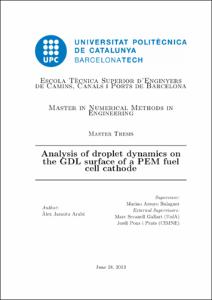Mostra el registre d'ítem simple
Analysis of droplet dynamics on the GDL surface of a PEM fuel cell cathode
| dc.contributor | Arroyo Balaguer, Marino |
| dc.contributor | Secanell Gallart, Marc |
| dc.contributor | Pons i Prats, Jordi |
| dc.contributor.author | Jarauta Arabí, Àlex |
| dc.date.accessioned | 2015-06-09T14:52:06Z |
| dc.date.available | 2015-06-09T14:52:06Z |
| dc.date.issued | 2013-06-28 |
| dc.identifier.uri | http://hdl.handle.net/2099.1/26169 |
| dc.description.abstract | A fuel cell is an electrochemical device that has the ability to turn the chemical energy in a fuel directly into electricity with high e ciency. Inside the fuel cell, oxidation and reduction electrochemical reactions take place producing low-voltage current (DC) and heat. The former is used to do useful work while the latter is wasted or can be used in cogeneration applications. Fuel cells are usually compared with other energy convertors, like reciprocating engines or batteries. Batteries and fuel cells have the same operating principle, based on the electrochemical reactions at the anode and the cathode. The main di erence being that batteries store the reactant inside the cell instead of in a separate storage tank. There are di erent types of fuel cells depending on the materials used in the electrolytes, the substances that react in the anode and the cathode or the working temperature. The current work focuses on Polymer Electrolyte Membrane (PEM) fuel cells, which can work between -40 and 100 C and use hydrogen as fuel, oxygen as cathode reactant and Na on® as the electrolyte (Figure 1.1). The working principle of the PEM fuel cell is based on two electrochemical reactions. The process starts at the anode, where the hydrogen ows in the anode Gas Flow Channel (GFC) and di uses through the pores in the Gas Di usion Layer (GDL). Attached to the GDL is the Catalyst Layer (CL). The CL is made using a platinum-based ink which is painted on either the PEM or the GDL. The ink contains carbon, Pt and electrolyte. The resulting coating is a thin (about 10 m) porous layer. The Pt catalyses the rst reaction: the hydrogen oxidation reaction.H2 ! 2H+ + 2e- (1.1) After this reaction, the next layer is the membrane which is made of Na on®. The membrane allows the protons to travel across its section but it is impermeable for the electrons and gases. The electrons have to go back through the GDL and the current collector (that act as the walls of the anode gas ow channel) in order to meet the protons at the other side of the membrane, thus generating the desired electric current. In the cathode, the oxygen ows in the cathode gas channels, di uses through the GDL and in the catalyst layer reacts with the protons from the membrane, performing the second reaction: 2H+ + 2e- + 1 2 O2 ! 2H2OThe union of the anode GDL and CL, membrane and cathode CL and GDL is also known as Membrane Electrode Assembly (MEA). When fuelled with hydrogen, the fuel cell has zero emissions, since the only product of the electrochemical reaction is water and heat. The water generated in the reaction is one of the key factors in uencing the fuel cell performance. The membrane needs water in order to conduct the protons; if there is not enough water, the membrane dries out and the fuel cell cannot work any longer. Alternatively, if there is too much water, the pores in the CL and GDL ood preventing the reactant gases from di using through it. The exceeding water has therefore to be evacuated through the cathode gas channels. This is the starting point of the present work. There are three types of two-phase ow in the gas channels depending on di erent factors. Their names change depending on the author, however, these ows are usually known as droplet, lm and slug ow [2], as shown on Figure 1.2. The present work focuses on droplet ow and the conditions that lead to lm and slug ow. Since it is very di cult to develop an analytical equation for the shape of a water lm, the best way to proceed is the analysis of a single static and deformed droplet and then identify the conditions that lead to lm and slug ow formation. In addition, the area coverage of the formed droplets is another variable that needs to be considered, and this variable takes values from 0 to 1 only when the ow is identi ed as droplet ow. |
| dc.language.iso | eng |
| dc.publisher | Universitat Politècnica de Catalunya |
| dc.rights | Attribution-NonCommercial-NoDerivs 3.0 Spain |
| dc.rights.uri | http://creativecommons.org/licenses/by-nc-nd/3.0/es/ |
| dc.subject | Àrees temàtiques de la UPC::Enginyeria civil |
| dc.subject.lcsh | Fuel cells |
| dc.title | Analysis of droplet dynamics on the GDL surface of a PEM fuel cell cathode |
| dc.type | Master thesis |
| dc.subject.lemac | Piles de combustible |
| dc.rights.access | Open Access |
| dc.audience.educationlevel | Màster |
| dc.audience.mediator | Escola Tècnica Superior d'Enginyers de Camins, Canals i Ports de Barcelona |
| dc.audience.degree | MÀSTER UNIVERSITARI EN MÈTODES NUMÈRICS EN ENGINYERIA (Pla 2012) |


